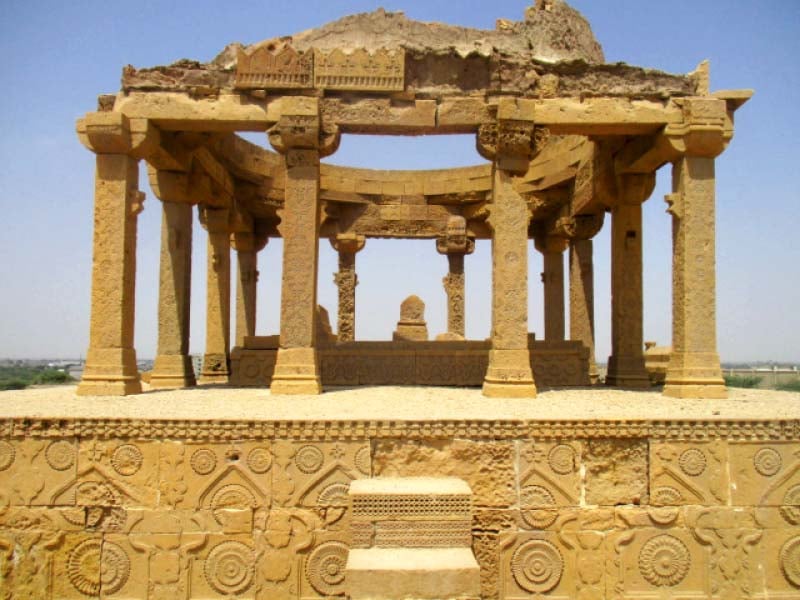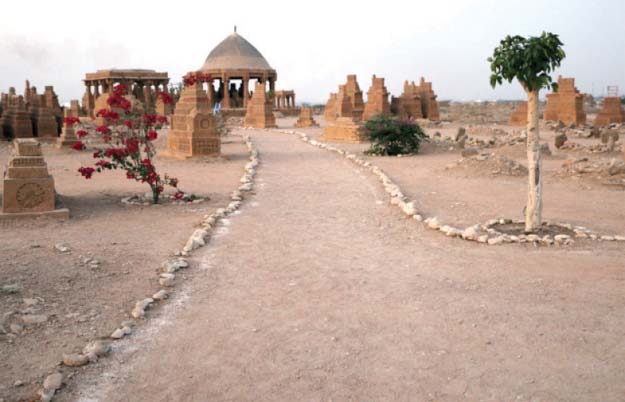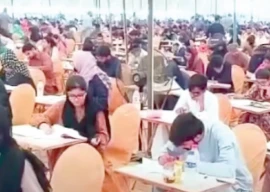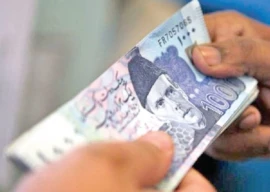
The site, which is commonly known as the Chaukhandi Graveyard, is a symbol of Sindh’s cultural heritage and is said to be hundreds of years old. Per sources, the graveyard serves as the resting place for the people of the local Jokhio tribe as well as Saloch warriors. Historians say that the graveyard was created during the 17th and 18th centuries AD.
According to the official website of the Sindh Culture, Tourism and Antiquities Department, the tombs boast exquisite stone carving which has persisted despite wear and tear for hundreds of years. “The style of the graves’ architecture is typical, one which is native to Sindh. That style is found nowhere else in Islamic countries,” the website stated.

Speaking to The Express Tribune, the Antiquities and Archaeology Department’s director-general Manzoor Ahmed Kansro said the conservation and renovation of the historical monument had been initiated two weeks ago.
“The work was scheduled to be completed by the end of June this year but this is not possible anymore due to the Covid-19 pandemic and the subsequent suspension of official activities. Hopefully, the work will now be completed by end of September,” Kansro said.
It is pertinent to mention that the administrative control of the Chaukhandi Graveyard was transferred to the Sindh government by the Centre under the 18th Amendment, along with other archaeological sites in the province.
Before that, the ancient graveyard neither had its limits defined nor had a boundary wall because of which it remained at risk of illegal encroachment and theft of its ancient bricks and yellow sandstone. It also continued to be a lucrative option for land grabbers because of its prime location, situated as it is on the main National Highway.
Sources revealed that several attempts were made by the land mafia to occupy the graveyard in the past. An encroachment attempt was also made during the tenure of the former Sindh chief minister, Arbab Ghulam Rahim. What’s more, some of the graveyard’s adjoining land is under litigation at the Sindh High Court.
The Sindh Culture, Tourism and Antiquities Department, however, took a major step around a year ago to protect the graveyard’s undisputed area.
“It was necessary to protect Chaukhandi Graveyard’s undisputed area from illegal encroachment. Therefore, the department erected a boundary wall around it and deputed watchmen there,” Kansro said.
He said the Centre had transferred the site to the Sindh government without the provision of any official records. “At the time of the transfer, the provincial government was also not given funds and technical staff. As a result, the culture department had to make all the arrangements on its own to run and protect the historical site,” he added.
Apart from illegal encroachments, the site was also at risk because a large number of deceased people belonging to nearby communities continued to be buried there.
“People living in surrounding areas of the Chaukhandi Tombs found it convenient to bury their relatives in this graveyard of historical importance. This practice was also stopped after the erection of the boundary wall,” Kansro explained.
Shedding light on the meaning of the word ‘Chaukhandi,’ he said that archaeologists and historians have come up with different interpretations. Per the website of the culture department, some scholars believe that Chaukhandi is the name of a place, whereas others consider it an architectural term. The tomb of Jam Murid bin Hail in the graveyard also has the word “Chaukhandi” engraved on it, which is believed to be the family name of the deceased.
Published in The Express Tribune, June 4th, 2020.





1732176172-0/Untitled-design-(8)1732176172-0-270x192.webp)
1732175528-2/Untitled-design-(5)1732175528-2-270x192.webp)










COMMENTS
Comments are moderated and generally will be posted if they are on-topic and not abusive.
For more information, please see our Comments FAQ